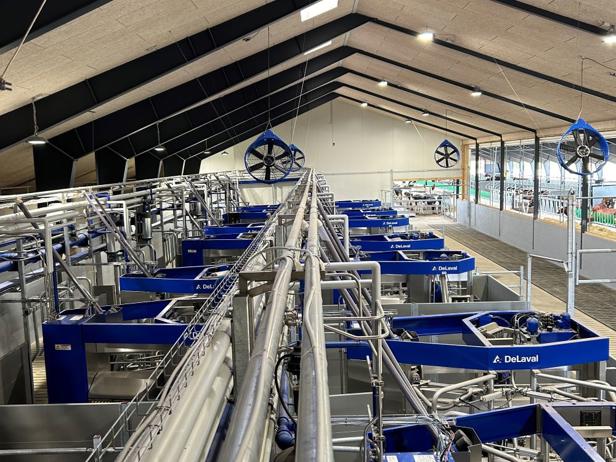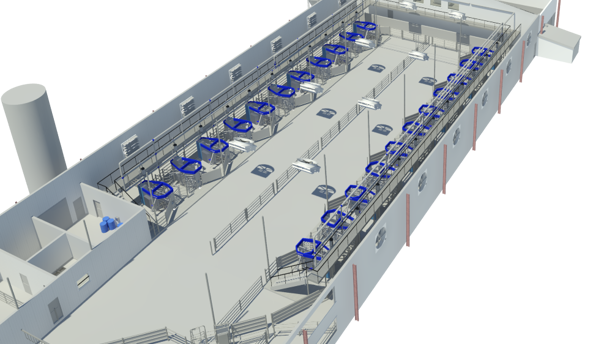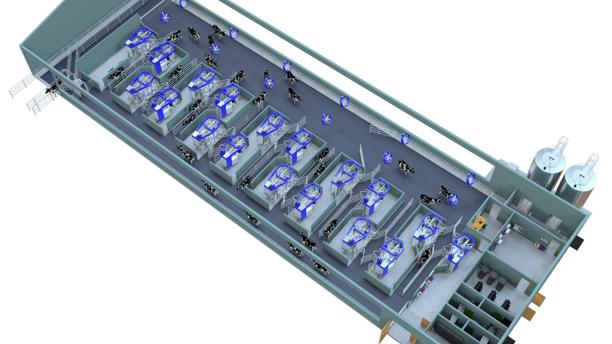
従来型搾乳と技術革新の融合:VMS™バッチミルキング
VMS™による「バッチミルキング」とは?
VMS™による「バッチミルキング」は、搾乳ロボットを使用して予め設定した時間に牛群を搾乳するシステムです。
搾乳プロセスを自動化することで人間の介入が不要になると同時に、従来の搾乳ルーチンを維持しながら、搾乳と給餌のスケジュールを酪農家自身が管理できるようになります。
VMS™は、搾乳カップの取付、牛の健康状態の監視、乳量や乳質に関する重要なデータ収集を行い、処理します。VMS™バッチミルキングでは、牛が24時間いつでも搾乳される従来の搾乳ロボットシステムと異なり、予め設定した時間で搾乳を行います。このため、現在パーラーやロータリーを使用しており、定時搾乳に慣れている酪農家にとっては、自動化の利便性と従来の搾乳ルーチンをそのまま活かしながらも、より簡単な運営と作業が可能になります。

こちらの動画は、デンマークでVMS™バッチミルキングを導入した「ロンホルムアグロ牧場」の実際の搾乳の様子です。すべての牛が自然にVMS™へ入場していることが良くわかります。
定時での搾乳
酪農家は牛群に対して予め搾乳スケジュールを設定します
自動化の高い効率性を最大限に活用
搾乳作業はすべてVMS™が行うため、人間による手作業を最小限にとどめます
酪農家の意思による稼働
給餌と搾乳時間の管理は依然として酪農家が管理します

VMS™バッチミルキングはどのように機能するのでしょうか?
- 牛はまず、泌乳段階や生産レベル、給餌方法などに基づいてグループに分けられます。
- これらのグループは、中央の待機場を含むパラレルパーラーに似たレイアウトで配置された複数のVMS™がある搾乳室に移動します。
- 各グループの牛は、VMS™で順次同時に搾乳されます。
- 搾乳後、牛はセレクション(選別)ゲートを通って出ていき、健康状態による選別エリア、キャッチペン、元の牛舎、または次の放牧エリアなど、適切なエリアに誘導されます。
- 搾乳セッション終了後、機器は自動的に洗浄および消毒を行い、高い生乳品質を維持します。
- このプロセスが次の牛群(グループ)でも繰り返されます。牧場は、既存のルーチンと給餌方法を維持しつつも、搾乳の自動化が可能になります。
VMS™による「バッチミルキング」が世界中で注目を浴びています
酪農家が大規模な牛群を管理する上で、より効率的な方法を模索する中、搾乳ロボットを使用して予定された時間に牛群から搾乳する「VMS™バッチミルキング」が急速に注目を集めています。
この方式は、中~大規模の酪農事業運営を念頭に設計され、自動化と従来の搾乳の構造の組み合わせで、日常業務を簡素化します。
多くの酪農家にとってシンプルでありつつも、VMS™が持つ多様なデータ収集・活用はそのままに、これまでの手法と統合しながら作業環境の改善が見込めます。
これらの理由から、現代の酪農業にとって新たな選択肢の1つとなりつつあります。
アメリカ・テキサスの牧場では、VMS™バッチミルキングの画期的なメリットを日々体験しています。この手法は、牧場にどのような変化をもたらしているのでしょうか?是非動画をご覧ください。
VMS™によるバッチミルキングのメリットとは?
VMS™でのバッチミルキングは、従来の方法と最新のロボット技術を融合し、より少ない作業で大規模牛群を効率的に管理することが可能です。この方法は、必要なときだけロボットを稼働させることで労働力、水、エネルギーなどのリソースの使用を最適化し、乳頭からバルクタンクまで一貫した流れと持続可能性に貢献します。
シームレスなシステム統合
バッチミルキングは、現在の牛の管理とTMRの給餌方法の維持が可能なため切替が簡単です。牛は新しいルーチンにすぐに適応し、従業員へのトレーニングも最小限に抑えられます。
大規模牧場向けのシンプルな運営
大規模牧場の業務を合理化し、手動搾乳の手間を減少させます。大規模な牛群でも管理が容易になり、スタッフのストレスが軽減され、日常業務がスムーズになり、貴重な時間管理に貢献します。
牛の健康の維持
VMS™V300は牛に優しく正確な設計が特長です。過搾乳を最小限に抑え、最適な衛生状態を維持し、穏やかで一貫した搾乳プロセスでストレスを軽減します。牛の健康にも配慮することで生乳品質が向上し、牧場の生産性が向上します。
酪農業の未来を見据えたインフラ設計
将来の技術進歩に適応するように設計されており、新しいイノベーションが誕生してもロボットシステムを簡単に拡張、またはアップグレードでき、投資が適切かつ有益であり続けるように設計されています。
持続可能性の向上
貴重な労働力、水、エネルギーの使用を最適化することで持続可能性を最大限に高めるとともに、効率的な牧場運営を通じてアニマルウェルフェアをサポートします。

農業法人F.lli Aceto(イタリア)の導入事例
イタリア・カラブリア州にある「農業法人F.lli Aceto」のオーナーの 1 人であるレナート・アセト氏は、VMS™によるバッチミルキングへの移行を決めました。
「私たちは既成概念にとらわれずに考え、この革新的なシステムを導入しました」と、移行の理由を説明しています。最初は VMS™への切り替えに不安を感じていましたが、すぐにその不安は杞憂であることがわかりました。最終的に、システムの使いやすさ、成長の可能性、既存の飼料管理を維持できることで価値を享受しました。8 台のVMS™を導入し、わずか3年で480 頭以上の規模拡大をする準備が整いました。
従来のVMS™設計やパーラー、ロータリーとどのように違うのでしょうか?
従来の自動搾乳とのコンセプトの違い
従来のVMS™のコンセプトでは、牛はロボットにいつでも自由にアクセスでき、自分で搾乳したい時間を選択できますが、VMS™バッチミルキングは固定した搾乳スケジュールで行われます。このアプローチでは、牛をグループで搾乳エリアに連れていくため、搾乳プロセスが合理化され、特に中~大規模牧場での効率向上が期待できます。
従来の自動搾乳設定を優先する代替案と考える場合は、VMS™バッチミルキングの次の利点を考慮してください。
- 自動搾乳中にコスト効率の高いTMR給餌を維持します。
- 自動搾乳の場合に必要な物理的な場所が複数必要なのに対し、VMS™バッチミルキングでは、牛とミルクの分離が 1 か所で実現可能です。
- 牛舎内に牛がいない状態で、牛床の清掃ができます。
- 搾乳のために牛追いを行う必要はありません。フリーカウトラフィックシステムでは、5 ~ 10%の牛を少なくとも 1 日に 2 回搾乳のために追ってくる必要があることがよくあります。
- 24時間いつでもアラームに対応できるようにするための準備が不要です。同じバッチシステム内に他の複数のステーションがあるため、仮にステーションの 1つが動作を停止しても残りのロボットで搾乳を継続することができます。
パーラーおよびロータリー
従来のパーラーおよびロータリーは搾乳スケジュールに従いますが、搾乳ユニットの取り付けなどの作業には、より多くの手作業が必要です。VMS™バッチミルキングでは、自動化とデータ収集のレベルが高まり、より適切な牛群の健康状態監視と乳房の健康管理が可能になり、情報に基づいた意思決定が可能になります。
パーラーまたはロータリー搾乳を使用する場合は、バッチミルキングの次の利点を考慮してください。
- 現在と同じように牛の管理と給餌を行い、搾乳作業が自動化するだけです。
- 自動搾乳では、一貫したルーチンが提供されるため、新しい従業員をトレーニングする必要がありません。
- 搾乳環境のストレスが少ないため、牛は落ち着いて搾乳にのぞめます。
- 将来、ロボットを拡張したり、新モデルにアップグレードをすることが容易です。
VMS™バッチミルキングに最適なのはどんな牧場でしょうか?
人件費が上昇し、労働者の確保が困難になるにつれて、VMS™バッチミルキングは手作業を減らし、スタッフが日常業務ではなく全体の監視やシステム通知への対応に集中できるようになります。

500~2,000頭の牛を飼養する牧場に最適
VMS™バッチミルキングは、500~2,000頭の牛を飼養する中~大規模牧場に最適です。このような規模の牛群を管理するには、時間がかかり、労働力が集約されがちです。VMS™バッチミルキングは、搾乳プロセスを自動化し、時間を節約、貴重なリソースを最適化します。
このシステムは、牛群の健康、生乳生産、給餌を監視するための貴重なデータを提供し、牧場のパフォーマンスを常に把握できるようにします。VMS™バッチミルキングの導入は、生産性を高めて労働力をより効率的に管理できます。牧場の近代化や拡張に最適で、既存の運営方法とシームレスに統合が可能です。

何頭の牛を搾乳できますか?
VMS™バッチミルキングのセットアップ容量は、VMS™ステーションの数、搾乳頻度 (1 日 2 回、2.5 回、または 3 回)、システムの稼働時間など、いくつかの要因によって決まります。その他の要因には、牛の泌乳速度、牛の品種、オペレーターがシステム内で牛の移動をどれだけうまく管理しているかなどがあげられます。
処理能力は通常、1ステーション・1 時間あたり7 頭~8.5 頭の範囲です。セットアップに必要なロボットの台数も牛舎内のグループのサイズによって異なります。

VMS™バッチミルキング設計はどのようなものがありますか?
VMS™バッチミルキングの設計は、牧場ごとに大きく異なります。コスト効率の高い構成を選択する牧場もあれば、高効率システムを優先する牧場もあります。VMS™システムは柔軟性が高いため、慎重に計画と設計を行うことでさまざまな規模の牧場に適応できます。
適切に設計されたVMS™バッチミルキングでは、効率と柔軟性のバランスを取ることを目的としています。通常、これには幅 5.5~7.2メートルの待機場と、牛の移動を効果的に管理するために自動または手動ゲートが装備されています。
牧場は、特定のニーズに基づいてさまざまなレイアウトを適応できます。
例えば・・・
• バックゲート付きの幅の狭い待機場:
14 台のVMS™ユニットを備えた牧場では、人による清掃作業の手間を減らすために待機場の幅を狭くして、マニュアスクレーパーを導入しています。
• クラウドゲート:
牛の流れを管理するためにクラウドゲートを使用する牧場もあります。
しかし、これにより牛がロボットにアクセスできなくなるため、搾乳の機会が制限されることがあります。上手く設計された待機場では多くの場合、クラウドゲートが不要になり、よりスムーズで効率的な搾乳が可能になります。